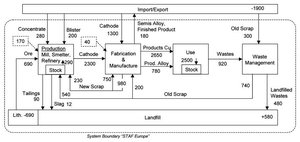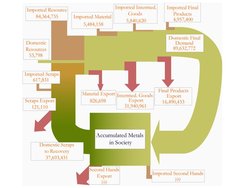Metal cycle
| Topics: |
Metals play an important and obvious role in the economy and society. They are also a source of environmental damage during the process of extraction from the earth and through releases to air, water and land throughout their life cycle of production, use and disposal. Materials flow analysis (MFA) is an analytical tool for the characterization of the quantity of material stocks and flows throughout the product life cycle in order to enable better understanding of resource use and availability and of the sources of environmental releases. Characterization of the flow of substances in nature has long been part of the study of biogeochemistry—particularly the characterization of carbon, nitrogen, sulfur and phosphorus in the “grand nutrient cycles.” The characterization of human-induced flows such as metals is a more recent contribution, from the field of industrial ecology.
A metal cycle for stocks and flows characterizes the entire life cycle of the metal. The study is often performed on metals that play a significant role in human activities, such as copper (Cu), zinc (Zn), iron (Fe), and nickel (Ni). An MFA can conducted on country level, regional level, the world as a whole, or any other scope that is of interest to the researcher.
The system boundary for a metal cycle is usually drawn by political unit, e.g. countries. The processes through which the metal goes are typically production, fabrication and manufacturing, use and waste management. Furthermore, each major process may include multiple sub-processes. For example, production can be disaggregated into extraction, mining, milling, smelting, and refining. Between the processes (or sub-processes) are the markets, where imports and exports of the metal in various forms often occur. An important difference between the metal cycle and the cycle of other natural resources is that the metal cycle is dominated by anthropogenic (human-caused) activity throughout the metal’s lifetime.
Metal cycles typically are presented as “best estimate”, as the data used to construct the cycle are obtained from diverse sources with varying reliability. The rule of mass balance, based on the conservation of mass from the first law of thermodynamics—what goes in = what goes out + net addition to stock—is almost never perfectly satisfied. However, the resulting error, often called the closure error, can be made explicit in the results and is often reduced on a more aggregated level.
The results of the study of a metal cycle provide accounting information on how much metal enters the economy, is added to in-use stock, and is thereafter recycled or landfilled. Such study can also provide information on the emissions of the metal into the environment across its various life cycle phases. Moreover, the results can shed light on questions such as whether unconventional reservoirs of metals such as landfills may be an alternative source of metal resources in some circumstances. The study of metal cycles is thus useful for analysis of global and local resource availability, environmental impact of metals, trend forecasting, and policy making.
Further Reading
- Bertram, M., T.E. Graedel, K. Fuse, R. Gordon, R. Lifset, H. Rechberger, S. Spatari, 2003. “The Copper Cycles of European Counties”. Regional Environmental Change, 3:119-127.
- Graedel, T. E., 2002. The contemporary European copper cycle: Introduction. Ecological Economics 42(1-2): 5-7.
- Lifset, R., R. B. Gordon, T. E. Graedel, S. Spatari, and M. Bertram, 2002. Where has all the copper gone: The stocks and flows project, part 1. JOM: 21-26.
- Murakami, Shinsuke, 2006. "Material Flows and Stocks of Metals Surrounding Japan". Symposium on Advanced Material Flow Analysis for the Sustainable Society, 187-190, Sendai.

